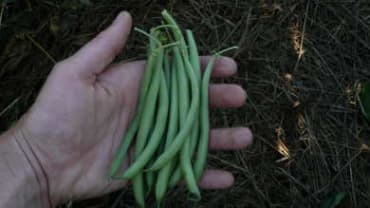(53 days) Open-pollinated. Market growers will strike it rich with heavy yields of medium-green 5½" slender smooth straight round pods. Strike sets the standard for earliness, appearance and ease of picking, and has a pleasing sweet beany taste. White seed. Resistant to NY 15 and CBMV. ③ ④ ⑤
Strike Bush Green Bean
Strike Bush Green Bean
(53 days) Open-pollinated. Market growers will strike it rich with heavy yields of medium-green 5½" slender smooth straight round pods. Strike sets the standard for earliness, appearance and ease of picking, and has a pleasing sweet beany taste. White seed. Resistant to NY 15 and CBMV. ③ ④ ⑤
Additional Information
Bush Beans
About 120 seeds/2 oz packet. 2 oz packet sows 25 ft; 1 lb, 200 ft. Seed sizes vary. Pick frequently for maximum and steady yields, but avoid harvesting or disturbing foliage in wet conditions to prevent spread of fungal diseases. Successive plantings can be made every 2 or 3 weeks until midsummer.
Bush Beans
About 120 seeds/2 oz packet. 2 oz packet sows 25 ft; 1 lb, 200 ft. Seed sizes vary. Pick frequently for maximum and steady yields, but avoid harvesting or disturbing foliage in wet conditions to prevent spread of fungal diseases. Successive plantings can be made every 2 or 3 weeks until midsummer.
Bush Beans
About 120 seeds/2 oz packet. 2 oz packet sows 25 ft; 1 lb, 200 ft.
Seed sizes vary. Pick frequently for maximum and steady yields, but avoid harvesting or disturbing foliage in wet conditions to prevent spread of fungal diseases. Successive plantings can be made every 2 or 3 weeks until midsummer.
Beans
- All beans are open-pollinated.
- Days to maturity are from emergence after direct sowing.
Culture: Tender, will not survive frost. Inoculate with a legume inoculant, then plant seeds 3–4" apart in rows 24–30" apart after all danger of frost has passed and soil has warmed. Minimum germination soil temperature 60°; optimal range 70–80°. White-seeded beans are generally more sensitive to cold soil temps than dark-seeded varieties. Legumes have moderate fertility needs and can fix their own nitrogen. Excessive nitrogen may induce some bush varieties to develop vines in moist hot weather.
Saving Seed: Saving bean seed is easy! Leave pods on the plants to dry. Hand shell, or stomp pods on a tarp. To ensure true-to-type seed, separate varieties by 30 feet.
Diseases:
- ANTH: Anthracnose
- BBS: Bacterial Brown Spot
- CBMV: Common Bean Mosaic Virus
- CTV: Curly Top Virus
- DM: Downy Mildew
- HB: Halo Blight
- NY 15: NY 15 Mosaic Virus
- PM: Powdery Mildew
- PMV: Pod Mottle Virus
- R: Rust
- SC: Sclerotina
White mold, Sclerotinia sclerotiorum, affects more than 300 plant species. In beans, low humidity, good air circulation and wider spacing, both between plants and between rows, reduce the likelihood of this soil-borne infection.
Germination Testing
For the latest results of our germination tests, please see the germination page.
Our Seeds are Non-GMO

All of our seeds are non-GMO, and free of neonicotinoids and fungicides. Fedco is one of the original companies to sign the Safe Seed Pledge.


